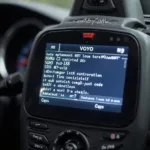OBD2 codes are the key to unlocking the secrets of your vehicle’s health. These alphanumeric codes, accessed through an OBD2 scanner, offer valuable insights into potential issues affecting your car’s performance, emissions, and overall well-being. This comprehensive guide will delve into the world of OBD2 codes, explaining their significance and how you can leverage them for effective vehicle maintenance.
What are OBD2 Codes?
OBD2, short for On-Board Diagnostics II, is a standardized system implemented in vehicles to monitor and report malfunctions within various systems. When a problem is detected, the OBD2 system generates a specific code that pinpoints the nature and location of the fault. These codes, known as Diagnostic Trouble Codes (DTCs), are crucial for mechanics and car owners alike in diagnosing and resolving car problems. Understanding these codes can save you time and money by allowing you to address issues promptly and avoid unnecessary repairs.
Types of OBD2 Codes
OBD2 codes are categorized into several types, each representing a specific area of the vehicle’s system. The most common types include:
- P Codes (Powertrain): Relate to the engine, transmission, and other powertrain components. You can find more information about powertrain fault codes on our dedicated powertrain fault codes for obd2 page.
- B Codes (Body): Refer to issues with the body, such as airbags, power windows, and central locking.
- C Codes (Chassis): Pertain to problems with the chassis, including anti-lock brakes, steering, and suspension.
- U Codes (Network Communication): Indicate communication errors between different control modules within the vehicle.
How to Read and Interpret Codes for OBD2
Each OBD2 code follows a specific structure, consisting of a letter and four digits. The letter indicates the system (P, B, C, or U), while the digits provide further details about the specific fault. For example, P0300 indicates a random misfire, while P0420 signifies a catalytic converter efficiency issue. Understanding this structure allows you to quickly identify the area of concern. You can find more information about OBD2 code readers on our dedicated codes for obd2 code reader page.
Using an OBD2 Scanner
To retrieve OBD2 codes, you need an OBD2 scanner. These devices, available at various price points and functionalities, connect to your vehicle’s OBD2 port and display the stored codes. Some advanced scanners even provide real-time data and troubleshooting guidance. Our website offers reviews and comparisons of various codes for obd2 scanner to help you choose the right one for your needs.
Common Codes for OBD2 and Their Meanings
While there are thousands of potential OBD2 codes, some occur more frequently than others. Familiarizing yourself with these common codes can give you a head start in diagnosing your car’s problems. For instance, P0420 (catalytic converter efficiency below threshold) often indicates a failing catalytic converter, while P0171 (system too lean bank 1) suggests a problem with the air/fuel mixture.
Clearing OBD2 Codes
After addressing the underlying issue, it’s essential to clear the OBD2 codes using a scanner. This confirms the fix and prevents the code from triggering unnecessary warnings. However, simply clearing the code without fixing the problem won’t resolve the issue, and the code will likely reappear. We have a helpful article on how to tell if obd2 codes have been erased.
Conclusion: Mastering Codes for OBD2 for Effective Vehicle Maintenance
Understanding codes for OBD2 empowers you to take control of your vehicle’s health. By utilizing an OBD2 scanner and interpreting the retrieved codes, you can proactively address issues, prevent costly repairs, and ensure your car runs smoothly and efficiently. For those interested in a compact and portable solution, we also have information on codes for obd2 pocketscan.
FAQ:
- What does OBD2 stand for? On-Board Diagnostics II
- Where can I find the OBD2 port in my car? Typically under the dashboard on the driver’s side.
- Can I fix my car just by clearing the codes for OBD2? No, clearing codes only resets the warning light; the underlying issue needs to be addressed.
- What does a P code indicate? A powertrain-related problem.
- How can I learn more about specific OBD2 codes? Consult a repair manual or use online resources.
- Why are OBD2 codes important? They provide valuable diagnostic information about your vehicle’s health.
- What should I do if a code reappears after clearing it? Consult a mechanic to diagnose and fix the underlying problem.
Need help with your car diagnostics? Contact us via WhatsApp: +1(641)206-8880, Email: [email protected] or visit our office at 789 Elm Street, San Francisco, CA 94102, USA. Our 24/7 customer support team is always ready to assist you.
